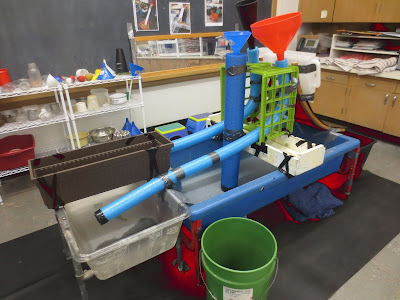On the opposite side, I taped a toner deposit container to a curved ramp made from an old rocking chair to create the water fall.
This was the type of elementary pouring that happens at the water table when there is no apparatus.
In the picture below, the child also transferred water from one container to another. However, first she wedged one watering can through a hole in the bottom of the planter tray. Using a second watering can, she tried to pour water from spout to spout.
Besides being quite inventive, the child transformed the operation into one that was more exacting. The child used two hands, one to steady the watering can and one to lift and pour. It was also exacting because it required more precise eye-to-hand coordination.
In the video below, the child added a different challenge to his pouring. He stepped up onto a stool and reached as high as he could to pour water into the highest funnel of the apparatus.
For this child, the act of pouring became more physical. Not only did he have to reach with his full extension to pour, but he also had to balance his whole body as he leaned up and over to reach the black funnel.
In the video below, the child added another different challenge to pouring. She poured water from two different containers at the same time. To do that, she had to pour water from the metal measuring cup in her left hand using an overhand action. To pour water from the green plastic cup in her right hand, however, she had to use an underhand motion.
The other interesting challenge for this child was that she was pouring water into holes on a vertical axis. To get most of the water in the holes required a different type of dexterity and coordination than pouring water down into a container or funnel.
In the picture below, the child added yet another different challenge to pouring. For her, the act of pouring became one of power. She lifted a five gallon pail to pour the water into the planter tray.
It took strength to lift the bucket up and rest it on the lip of tray so she could control the rate of water flowing from the bucket.
Is pouring so simple? I do not think so. In the book The Hand, Frank R. Wilson states the following: "To a large extent, we remain ignorant of the fine details of muscular control of rapid hand and finger movement. There are thirty-nine muscles located in the forearm and hand..." p. 358. Wilson was not referencing pouring per se, but muscular control is at the heart of pouring, too. Not only that, but when we start to compile the number of muscles, tendons and ligaments in the upper arm, the shoulder and the rest of the body, I would think our ignorance grows exponentially.
Taken from the examples above, some of the physical skills needed to pour are flexion, eye-to hand coordination, arm and body extension, balance, dexterity, power, and coordination. Could pouring be a foundational skill for writing considering that pouring facilitates practice in gripping objects and completing complex hand movements? If so, we would do well to offer children more and varied opportunities to pour, including precision pouring and power pouring on multiple levels to promote extension and balance so they master the art of pouring.






Oh, what a superb link with literacy Tom, I really like your conclusion. I'd like to recommend the book "Prehension-The Hand and the Emergence of Humanity" by Colin McGinn; it covers the same hand/cognition ground and reasserts the need for all of us to "be handy"! (Frank Wilson thought it was a good read as well...)
ReplyDeleteThanks for the recommendation Aaron. Your recommendation for "The Spell of the Sensuous" was an excellent read. In fact, I have read it twice so far. Be well my friend.
Delete